Although I didn't realise it at the time, the start of my BBC career in the 1980s coincided with what might now be considered the golden age of analogue open reel tape. Following decades of development, both the recorders and the tape media were by then very refined products capable of high fidelity sound reproduction that was more than adequate for broadcast use. Although this period also saw the emergence of digital audio recorders, their high cost and the lack of 'edit-ability' of digital tapes, ensured that analogue open-reel remained the mainstream recording medium for most radio studio work well into the 1990s.
What follows is a look at how analogue open-reel tape became established as the preferred recording medium in BBC Radio, before eventually giving way to various digital formats.
The early days of magnetic tape recording During the BBC's early years, broadcasts were generally live to air or from commercial gramophone records. Rudimentary audio recording equipment was available at this time, but it was not well-suited to broadcasting operations and the quality of sound reproduction was poor. By the 1930s, cellulose nitrate disc recorders had started to provide the sort of usability and sound quality that the BBC required and these began to be used for recording programme material in BBC studios and on location. But just as the BBC began its use of disc recorders, magnetic tape was emerging as a possible alternative.
The principles of magnetic recording had first been demonstrated in 1898 by Danish engineer Valdemar Poulsen, using his Telegraphone machine. In 1924, German engineer Kurt Stille developed an office dictation recorder that improved on Poulsen's earlier designs, but still fell short of the sound quality required for broadcast. It was not until 1930 that magnetic recording began to show promise, when Ludwig (aka Louis) Blattner produced a recorder that used steel tape rather than wire as the magnetic medium. Known as the Blattnerphone, this recorder impressed BBC engineers sufficiently that one was installed at the BBC's Research Department premises for evaluation. Although better than the earlier wire recorders, reproduction from the Blattnerphone was still not considered good enough for music and its duties were confined to recording speech. In 1933, the Marconi Company purchased the rights to the Blattnerphone and developed the concept further, the result being the Marconi-Stille recorder, which the BBC installed at its Maida Vale studios. It's probably fair to say that neither the Blattnerphone nor the Marconi-Stille recorders were entirely successful, being cumbersome, mechanically unreliable, difficult to use and providing lower sound fidelity than disc recording.
In parallel with these developments in magnetic recording, the BBC was also evaluating the optical recording methods that were being used by the film industry. One of the recorders tried was the Philips-Miller, which was also installed at Maida Vale.
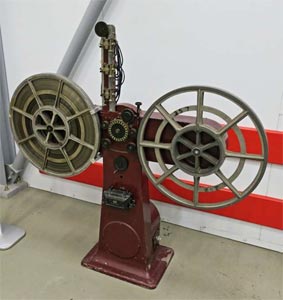
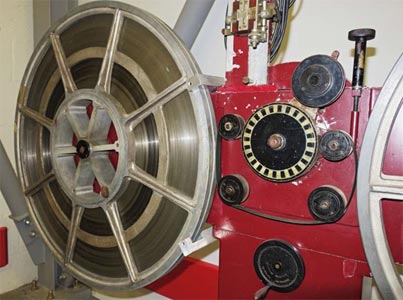
A Blattnerphone recorder, early 1930s.
A full spool giving 20 minutes of recording time contained over a mile of 6mm wide steel tape and weighed over 9kg. Splicing sections of tape together required a soldering iron and if the tape broke whilst the machine was running the loose ends presented a significant hazard to an operator!
A full spool giving 20 minutes of recording time contained over a mile of 6mm wide steel tape and weighed over 9kg. Splicing sections of tape together required a soldering iron and if the tape broke whilst the machine was running the loose ends presented a significant hazard to an operator!
A major disadvantage of early magnetic recorders such as the Blattnerphone was that they required large, heavy spools of relatively thick metal tape. Alternatives had been tried - notably a strip of paper tape with a coating of iron oxide, demonstrated by Valdemar Poulsen in 1928 - but the real breakthrough came in the 1940s when plastic recording tape was developed. This was produced either by mixing magnetic particles such as magnetite (Fe3O4) with polyvinyl chloride (PVC) during manufacture, or by first mixing the particles with a binder then applying a coating to one side of the PVC tape. The result was a much thinner and lighter recording medium which was also much more durable than paper.
In the late 1940s, BBC Research Department evaluated a number of German tape recorders such as the Tonschreiber B and Magnetophon HTS that used plastic-based tape. The Magnetophon HTS was of particular interest, being one of the first recorders to use ultrasonic bias to improve recording linearity. Although the BBC's engineers noted many deficiencies in the performance of these machines, it was clear that magnetic recording technology had advanced significantly during the Second World War.
Related page
Despite these advances, the BBC Research Department report on the EMI BTR/1 still concluded: "Although the general quality[…] was high, the reproduction was less clean than that obtained from a freshly cut disc." This, together with the fact that early tape machines were considerably more complex, expensive and bulky than disc players, ensured that direct-cut cellulose nitrate disc remained in use in some BBC locations well into the 1960s.
With all analogue recording systems, the quality of the reproduced audio depends on a complex interaction between the transport mechanism, the recorder's electronics and the physical properties of the recording medium itself. In the 1940s, the manufacture of magnetic tape - the process of coating a flexible base material with iron oxide particles - was still very much in its infancy. One of the first tapes to be widely used by the BBC was EMI H50, which entered regular service in the 1950s. H50 was produced using spherical iron oxide particles mixed with a binder and applied to a PVC base material. Although it was an improvement over the earlier tape formulations that the BBC had tested, H50 still suffered from significant variations in iron oxide particle size and coating thickness - deficiencies that noticeably degraded the sound quality - and would be considered poor by modern standards.
As the BBC's engineers developed a testing regime for recording tape, they no doubt provided feedback to the manufacturers, encouraging them to make improvements. Further product development by EMI resulted in a tape known as H77, which superseded H50 in BBC use from about 1960. H77 is prevalent in the BBC Archive and is also notable for its use by EMI Studios (now known as Abbey Road Studios) in recording the early Beatles albums.
 |
 |
 |
EMI H77 recording tape showing examples of early (left)
and later (right) styles of box artwork.
By around 1969, the BBC had drawn up its own specification for recording tape which it referred to internally as 'Type 100'. As tape usage began to increase it became clear that sourcing it from more than one manufacturer would be a sensible precaution, so that fluctuations in delivery or the emergence of faulty batches did not significantly disrupt the supply to users. The main requirement was that the chosen tape types had very similar magnetic properties in order to ensure a closely matched sensitivity across the audio frequency range. This was crucial for the BBC's operations, which required that a recording could be made in any location and played back in any other, without the need to re-bias and/or re-equalise a recorder for each tape. In contrast, commercial recording studios generally knew exactly which recorders were to be used for recording and playback, so it was reasonably practicable (and desirable) for them to optimise a tape machine for use with a particular tape before every session.
Test Rooms at Broadcasting House
In 1985, I joined the Recording Systems Section of Radio Engineering Services at Broadcasting House. Only then did I begin to appreciate the care and attention to detail that went into selecting the BBC's audio recording equipment and media.
Before discussing tape performance in more detail, it's worth describing the facilities that were available at Broadcasting House in the 1980s for carrying out detailed technical evaluation and investigation work. In addition to the general purpose workshops used by studio maintenance engineers, there was a suite of test rooms (numbered LG078 to LG082) located on the lower ground floor of Broadcasting House Extension. Often referred to simply as 'BHX', this building was demolished in 2006 but stood on the site now occupied by New Broadcasting House (NBH).
Some of these test rooms had specific purposes: one was equipped with a large console containing Brüel & Kjaer audio oscillators, filters, analysers and a chart recorder. This set-up was used in conjunction with a small anechoic chamber to test microphones. At the time, BBC Radio tested every single microphone purchased and kept records of their technical performance in case of query. So whenever operational staff suspected that a microphone sounded a bit 'off', it was possible to compare its current performance with that measured when it was new. Ultimately this practice was abandoned when it was concluded that the effort involved in testing every single brand new microphone outweighed any tangible benefit. To be fair, microphones had become much more consistent in performance than had been the case when this rigorous test regime began.
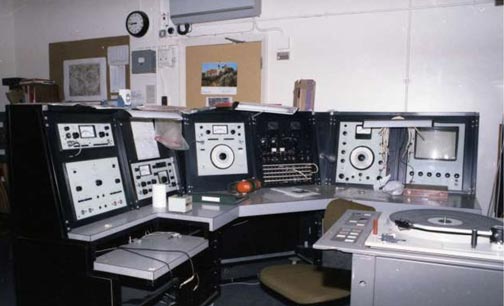 |
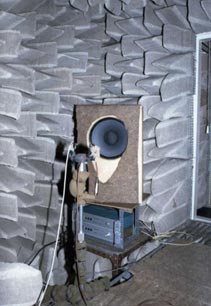 |
Microphone testing console and anechoic chamber, 1985.
Next door was an acoustically-treated listening room containing BBC monitoring loudspeakers, including LS3/7 with AM8/14 (modified Quad 303) amplifiers, a pair of LS3/5a and often a selection of commercial loudspeakers under evaluation. A range of high quality audio sources were available, such as a Studer A80 ¼ inch open reel tape recorder, Technics SP10 turntable with SME pickup arm, Nakamichi 1000 cassette deck, plus direct feeds of BBC Radio output from BH Control Room.
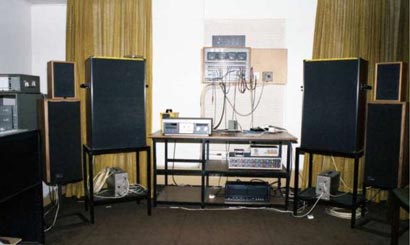 |
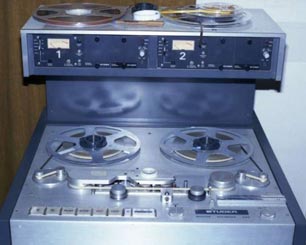 |
Listening room and Studer A80 ¼" Recorder, 1985.
Finally there was a room containing equipment for producing calibration tapes and for testing blank tape. This was equipped with a selection of recorders - notably a pair of Telefunken M15As, a Studer A80 multi-track that could be adapted for use with 1 inch or 2 inch tape, a Nagra recorder that had been modified to use 1/8" cassette tape and a selection of ITC 99 cartridge ('cart') machines. Studer C37 and Philips TR90 tape recorders were also present, although by the 1980s these were retained mainly for historical interest.
By today's standards these test rooms represented a generous amount of space, although of course audio recording and test equipment was considerably more bulky in those days. Much of what used to require a whole rack or console of equipment can now be done with a laptop, specialist software and high quality soundcard - not to mention fewer people!
Selecting the right tape for BBC use
Audio quality has always been a high priority for the BBC, but as mentioned previously there was an overriding requirement that tapes could be recorded on any one of hundreds of BBC tape machines then replayed on any other, without the need to re-adjust bias and/or equalisation settings.
The BBC solution to this problem was to apply very strict control to its blank tape supply and to use custom-made replay calibration tapes. I initially wondered why we went to the trouble of making our own calibration tapes, but when I had an opportunity to compare several commercially produced calibration tapes I found them to vary significantly. This was in spite of them all claiming to conform to the same standard! I soon understood that calibration tape production was a bit of a dark art: Those produced by the BBC were in reality no more 'correct' than the commercial products, but at least they conformed to a standard over which the BBC had full control.
By the 1980s, magnetic recording tape had undergone several decades of development and was a very refined product. However manufacturers continued to improve their tape formulations in small increments. Some of the credit for these developments should probably go to the humble Philips Compact Cassette which (with the help of Dolby Noise Reduction) had evolved into an acceptable hi-fi recording medium during the 1970s. Restricted in performance by its low tape speed and narrow tracks, the challenge was to produce increasingly higher output, lower noise tape formulations for this popular format. It's likely that these advancements also benefitted the professional open-reel tape products that were often produced in the same factories.
The BBC's huge consumption of audio recording tape - at its peak several hundred thousand reels per year - meant that reliance on a single supplier would have been too risky. Instead, concurrent supply contracts were drawn up with at least two tape manufacturers. The challenge that faced us was to identify competing tape products with near-identical performance.
Fortunately, most of the professional tape manufacturers of this era - for example Agfa, BASF, 3M, Ampex and Zonal - had at least one product within their range that broadly suited the BBC's requirements. Because of the size of the BBC tape contract, some manufacturers were even prepared to adjust their tape's characteristics slightly to match our specification. In return, the BBC allowed them to state that their product was "Specially made for the BBC" or "As used by the BBC", which was presumably seen by their other customers as an indication of high quality. This practice allowed us to interchange different brands of tape without this being apparent on line-up tone indicated on a PPM, or to the trained ears of a BBC Studio Manager.
Once the required tape performance had been defined, tolerances were placed on important parameters such as sensitivity, Maximum Output Level (MOL), saturation level and print-through. Periodic batch testing by the BBC ensured consistency and manufacturers were notified in the event that a product failed to meet the agreed standard, so that they could quickly rectify the problem.
BBC Type 200 tape specification
In 1986, I was given the task of reviewing the BBC tape specification. By this time, the original Type 100 had long since been superseded by Types 101, 102 and then in the early 1980s, by the Type 200 tape specification. There had been many improvements over the preceding 20 years, such as the introduction of acicular (needle-shaped) iron oxide particles which had superior magnetic properties to the spherical particles used in earlier tapes. Polyester had also superseded PVC as the base material for tape. Not only was polyester physically stronger and less prone to tearing, it also did not suffer from the 'pinholes' that had afflicted PVC and caused a type of signal dropout known as asperity noise. This was evident on playback as a characteristic 'bubbling' sound.
Type 200 was essentially the last analogue open-reel tape type in regular use by the BBC, although the manufacturers continued to refine its performance throughout the 80s and 90s.
 |
 |
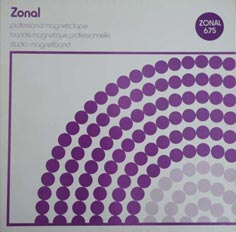 |
Examples of Type 200 Tape - 3M Scotch 256 "Specially
made for the BBC" and two generations of Zonal 675. Fortunately, recordings
made on these products have not faded - unlike some of the boxes!
Flux Level
An important parameter in determining tape performance is the density of magnetic flux - often simply referred to as 'flux level' - that can be recorded before the onset of distortion or high-frequency saturation. In essence, the higher the flux level that can be recorded onto a tape, the greater the signal to noise ratio, meaning that tape 'hiss' is less intrusive on playback. Each new BBC tape type allowed a higher flux level to be recorded than its predecessor, but this meant that all our recorders had to be realigned to take advantage of the improvement. This process was carefully managed, but inevitably it led to some confusion when a newer type of tape was introduced in some locations, whilst an older version continued to be used elsewhere.
Stereo 1/4 inch recorders using Type 200 tape were aligned so that 1kHz tone at an input level of PPM 6 (+8dBu) corresponded to a tape flux of 1000 nano-Webers per metre (nWb/m). Type 200's predecessors, Types 102 and 100, were only capable of operating at up to 640 and 400nWb/m respectively before the onset of significant distortion. Type 200 was also used in 1 and 2-inch formats on multitrack recorders. For these applications a lower maximum flux level of 400 (later 640nWb/m) was used in order to take account of the narrower track width and to allow more headroom on the wide dynamic range live music recordings for which multitrack machines were often used.
Line-up anomalies
As mentioned above, there were some instances where a mixture of tape types existed across the BBC. In particular, mono recorders were used in some locations and Type 102 tape continued to be used on these for some time after stereo recorders had been recalibrated for Type 200. This sometimes led to confusion during line-up, and it also proved necessary to modify some stereo machines so that their recording circuits would accommodate the newer Type 200 tape.
Another issue emerged when centre-track timecode became widely used in some studios in order to synchronise audio and video on separate tape machines. The timecode signal was recorded in the gap, or 'guard-band' between the left and right stereo tracks. This gap had been standardised at 2mm for timecode recorders, but was only 0.75mm on most stereo machines. The result was that when tapes containing timecode were played back on a standard machine, the timecode data signal would bleed across to the audio tracks. Even when timecode was not present, a small line-up anomaly occurred when a tape recorded on a 2mm guard-band machine was played back on a 0.75mm guard-band machine. This is due to the slight difference in the audio track width, a problem that was ultimately solved by migrating all the BBC's stereo tape heads from 0.75 to 2mm guard-band. Although reducing the audio track width to accommodate the larger guard-band caused a marginal reduction of signal-to-noise ratio this was a small price to pay for compatibility.
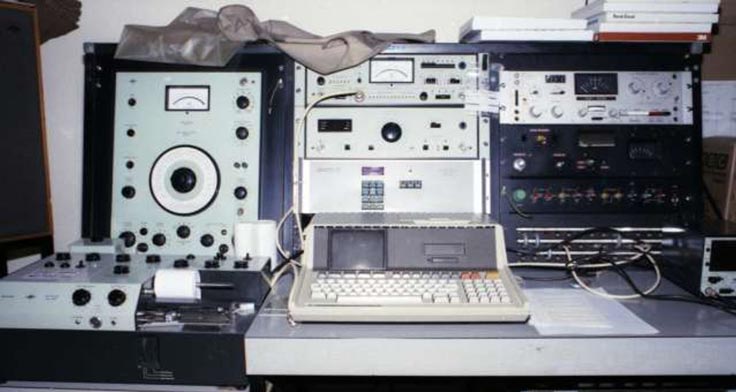
Tape testing console, 1985. A Hewlett Packard HP85 computer
was used to control ancillary equipment in order to automate some of the
test routines.
Tape speeds and noise reduction systems
The BBC generally used a tape speed of 38cm/s (15ips) for high quality music and drama recording, which resulted in a running time of just over half an hour for a 10 ½ inch reel (2400ft) of standard play tape. Other speech and news items were recorded at 19cm/s (7 ½ ips) which doubled the recording time. This was more convenient on portable recorders which could only accept small spools, but reduced the overall audio quality. The use of 76cm/s (30 ips) was confined to music mastering recorders at locations such as the BBC Maida Vale studios. Here, Dolby A (and subsequently SR) noise reduction systems were also sometimes employed. Noise reduction systems were not used in Radio's general purpose studios and recording channels because the benefits were outweighed by the extra alignment complexity and cost that this would have entailed.
Tape performance criteria
Two key performance criteria for tapes are Maximum Output Level (MOL) and high frequency saturation. These are a useful benchmark for determining how hard a tape can be 'driven' before the sound quality becomes unacceptable. Higher values of MOL and saturation enable higher magnetic flux levels to be recorded, resulting in a higher signal-to-noise ratio from the recorder electronics and the tape itself.
The MOL of a tape corresponds to 3% third harmonic distortion at 1kHz. This is generally considered to be the limit of acceptable performance, as driving the tape much harder than this causes harmonic distortion to increase exponentially. Similarly, saturation - normally measured at 10kHz - is the point at which the tape is unable to deliver any more output level at high frequencies due to magnetic saturation. BBC recorders were aligned so that there was a few dB of headroom between the peak line-up level of +8dBu and the measured MOL and saturation figures for the tape in use. This operating headroom was important because the Peak Programme Meters (PPM) used to measure levels in the recording signal chain under-read the true signal peaks on speech and music to a significant and varying degree which depends on the programme material. In practice, tapes were often driven very close to (and occasionally beyond) their MOL and saturation performance figures. Fortunately, analogue tape is reasonably forgiving under modest overload conditions - the sound tending to distort in a way that has more in common with dynamic compression and limiting than the unpleasant distortion caused by digital clipping.
When comparing tape specifications, many people tended to judge performance on the MOL and saturation figures alone, but that only told part of the story.
Print-through
BBC Type 200 tape was sometimes considered inferior to (then) state of the art tapes such as Ampex 456 Grand Master, which was popular with many commercial recording studios in the 1980s. Although such 'low-noise-high-output' formulations quoted impressive MOL and saturation figures, they often drew criticism when used in BBC applications because they tended to emphasise a tape characteristic known as print-through. This is caused by the recorded magnetic field on a tape 'printing' unwanted signals onto adjacent layers of tape on the reel - rather like a sort of magnetic crosstalk. The higher the flux level recorded on a tape, the more likely it is that a print-through signal will be able to penetrate one or more adjacent layers of tape and be audible above the noise floor. The printing process happens gradually from the moment a recording is made, but has usually reached its maximum after a tape has been stored for few days at normal room temperature. A higher temperature doesn't worsen the final print-through signal, but it increases the rate at which it develops. The practical consequence of print-through is pre- and post-echo heard on recordings - most evident on loud transients preceded and/or followed by silence. Recordings of speech and drama are particularly revealing of print-through and since these types of programme make up a significant proportion of the BBC's output, it was an important criterion when selecting tape products.
In order to test print-through performance, a series of 1kHz tone pulses were recorded onto the tape under test. The pulses were widely spaced, each being around 1 second in duration. The exact duration was not critical, so long as each pulse was followed by silence for several revolutions of the tape spool to enable the low level print signals to be audible during the interim periods of silence. The recording amplitude needed to be high enough for the print signals to be audible above the tape's noise floor, but not so high as to drive the tape into saturation. Once the pulses had been recorded, the tape was carefully rewound and stored in an incubator at 20°C for 72 hours. At the end of the storage period, the tape was replayed and the audio output fed into a chart recorder which displayed the recorded signal together with the print 'side-bands'. The separation in dB between the fundamental and the largest of the print signals was taken as the print value for the tape.

Print-through chart, showing fundamental tone pulses
at 0dBr with pre- and post-echo signals at -60dBr or below. The highest
measured echo amplitude was taken as the print-through value of the tape.
Two characteristics of print-through can be used to advantage by recording studios. The first is that the pre- and post-echo print signals have slightly different amplitudes (as can be seen in the chart, right) due to the physics behind the print-through process. If the more prominent print signal is post- rather than pre-echo, this is more acceptable because it tends to be masked by the natural decay in reverberation from the recording acoustic. It is possible to engineer this situation by leaving a tape 'tail out' (i.e. on the take-up spool) rather than rewinding it before storage. The second characteristic is that printed signals are magnetically much weaker than the main recording. In fact, print-through is such a weak magnetic effect that it suffers partial erasure from the friction of the tape surface against the tape guides on the replay machine. So the action of rewinding a 'tail out' tape immediately before replay reduces the amplitude of the print-through signal by a slight but useful amount. Unfortunately, 'tail out' storage did not fit in with BBC operational practice because there wasn't always time to fully rewind a tape immediately before transmission. Since the tapes with the highest MOL tended to emphasise print-through, the pragmatic solution was for the BBC to avoid their use for all except specialist applications where print-through was not likely to be noticed.
Performance tolerances
The tolerances that the BBC placed on Type 200 tape were quite strict. For example, production batches of tape were expected to vary in sensitivity by no more than ±0.5dB at 1kHz and ±1dB at 10kHz in relation to a reference sample known as the 'Type 200 Master'. To ensure that reference tapes did not wear out from repeated use, a hierarchy of closely matched master, sub-master and working master tapes taken from the same batch was established. These were handled very carefully and a log of their usage was maintained so that any deterioration could be monitored and tapes retired from service when they were no longer close enough in performance to the 'master' reference.
The velour effect
One tape anomaly that caught us out on occasion was something colloquially known as the 'velour effect'. This is an apt name as most tape exhibits a sort of 'magnetic pile', rather like the nap of velour or velvet fabric, which gives it slightly different properties depending on the direction of travel across the heads. The practical effect is that for most tapes, the high frequency sensitivity is higher in one direction than the other. The difference is generally less than 1dB at 16kHz, which is trivial in normal use, but significant when measuring against a strict performance tolerance. When we were testing tape, the 'correct' direction of travel was always taken to be the one that produced the highest sensitivity at 16kHz. As a result, it was useful to know in which direction a manufacturer loaded their tapes onto spools before despatch. 2400ft spools were generally loaded so they gave the highest sensitivity straight out of the box, but we soon learnt that the 1200ft spools that were occasionally supplied for our batch tests arrived with the tape loaded the other way round.
The velour effect tends to diminish with repeated use of a tape, being dependent on the smoothness or 'polish' of the tape surface. Running a tape across heads and guides a few times helps to smooth out surface imperfections. In the same way, a tape that has been highly polished during the production process exhibits minimal velour effect from new.
Long play (LP) tape
BBC Type 200 tape was only ever supplied to us in 'Standard Play' (SP) format, which had an overall thickness of 50µm. For a 2400ft reel this gives a nominal running time of 30 minutes at 15 inches per second. Tape offering extended recording times is significantly thinner, which worsens its print-through performance as well as making it physically less robust. For these reasons its use was avoided in normal BBC applications.
Continuous loop cartridge tape ('carts')
The BBC's obsessive approach to magnetic tape did not stop at open-reel. There was also a demand for good quality NAB AA cartridges or 'carts' that were widely used for station idents, jingles and programme trails. For test purposes and the production of calibration carts, the tape was supplied in open-reel form and was loaded into the plastic cartridge shells by an external company. The principle of the cart system is that the tape runs in a continuous loop, which requires adjacent layers of tape to slide against each other. To ensure smooth running, a graphite-based lubricant was applied to the tape surface during manufacture and as a result there was little adhesion between adjacent layers. This tape was often delivered on hubs without flanges and great care was needed when handling it. Failure to support the hub when a tape was being carried between box and machine could easily result in the hub, together with a large portion of the brand new tape, dropping onto the floor!
Compact Cassette
Analogue cassettes were often looked down upon in professional circles as they were not considered capable of producing 'broadcast quality' recordings. Even so, they were a convenient format on which to provide listening copies of material for programme makers and contributors. They were also more than adequate for use in RoT (Recording of Transmission) logging. BBC operational practice stipulated that audio derived from a cassette should not be used on air, but I suspect that this did occasionally happen. There are similar arguments today regarding the use of audio files that have undergone lossy compression to mp3 or similar.
For a while the BBC purchased basic quality ferric oxide cassettes and had these branded with its own logo. (In those days, the BBC, in common with other large organisations, applied its logo to almost anything portable, such as pens, canteen crockery, utensils and even mains plugs!) This practice was eventually stopped because the cost of having tapes re-branded made them as expensive as superior products from the leading cassette manufacturers of the time. Some effort was made to standardise cassette performance and alignment as for open-reel, but greater variation was inevitable with what was basically a consumer format. With care however, remarkably good performance could be obtained from the Studer / Revox cassette recorders that were a standard fitment in many BBC studios. The problem was in maintaining this high performance. We initially went to the trouble of producing our own calibration tapes, using a modified Nagra open-reel machine fitted with 1/8" heads and guides. Unfortunately, the key performance benefit arising from this practice - namely azimuth accuracy and stability - was lost once the tape had been loaded into a cassette shell. The practice was eventually dropped in favour of using commercial calibration cassettes.
Tape faults
No product is consistently perfect, so of course faulty tapes were encountered from time to time. Regular batch testing helped to identify problems early on, but some issues only became apparent once tapes were in service in a studio or recording channel. This is one reason why at least two different tape manufacturers were used. Switching to an alternative brand while a fault was investigated meant that continuity of supply to the user could be maintained. If an alternative brand was not available locally, a user would sometimes try to locate a different batch of the suspected faulty brand, since most problems tended to be confined to a short period in a production run.
All tapes had a batch number printed on the box and some brands such as Agfa helpfully repeated this information on the matt backing of the tape itself. Agfa tape also included a 'slit' number that defined the part of the 'jumbo' (a 2ft wide roll) from which the narrower width of tape had been cut. This presumably helped the manufacturer to identify the precise location of the faulty equipment on their production line.
Some tape faults were obvious to users, the most common being oxide shedding, where little piles of brown dust would accumulate on deck-plates beneath heads and guides and /or stick to the surface of the heads and guides themselves. Modern tape formulations such as Type 200 not only had a magnetic coating, but the reverse of the polyester base had a coating too. This was an inert matt finish, applied to minimise slippage between tape layers during fast-winding in order to create a nice smooth 'pack' of tape on the reel. A second function of this back-coating was to conduct away - by means of carbon particles in the backing mixture - any static electric charge that could build up during fast winding. As with the magnetic coating, shedding of the backing material sometimes occurred and whilst this didn't directly affect the quality of a recording, loose particles could still get between the tape and heads, resulting in signal dropouts.
Tape width variation was another physical fault that could be seen on close inspection or heard as a change in noise from the tape transport. Tape production involved applying the coatings to a 2ft wide polyester base which was then slit into the required widths for the final product. Like any cutting process, once the blades began to lose their sharpness they produced tape with uneven edges and sometimes the affected batches reached the customer. Straight out of the box, the smoothness of a new tape pack on its spool was a good indicator of slitting accuracy. Of course, such visual inspection did not necessarily mean that the tape was actually the correct width - just that it had been slit consistently. The effects of width variation on recording performance ranged from phase jitter to more serious 'scrape noise' and dropouts caused by the tape being too wide to fit between guide pillars or too narrow, so that it weaved up and down across the heads.
Some tape machines were much more sensitive to the slitting quality of tapes than others. In particular, Telefunken M15A machines used edge-guidance that relied on the lower edge of the tape being in continuous contact with a series of guides either side of the tape heads. These machines had exceptionally stable azimuth with low phase-jitter - but only when used with tape slit to the highest standards of accuracy and consistency. On the other hand, Studer recorders such as the A80 were marginally less impressive in terms of absolute azimuth stability, but tended to be more tolerant of different brands and types of tape.
Sticky shed syndrome
When it was first encountered, so-called 'sticky shed syndrome' caused great concern amongst recording and archiving professionals. It originally became apparent on certain tape formulations made in the 1970s, when manufacturers were devising new chemical compositions of binder - the substance used to hold the magnetic particles together and attach them to the polyester base material. Unfortunately certain binder compositions were subsequently found to be hygroscopic, meaning that they absorb moisture from the atmosphere. As a consequence, after a period in storage, tapes having this type of binder exude a sticky white substance that contaminates heads and guides. In extreme cases, the build-up of sticky deposits can be sufficient to slow or even stop the tape transport. Users are often first alerted to this problem by characteristic squealing noises from the tape machine as they replay an archive recording. Although originally attributed to certain production batches of Ampex tape, it became apparent that other manufacturers had used similar chemical formulations during this period, so their products can also be afflicted.
Fortunately, it was found that sticky shed syndrome can be reversed to some extent by carefully 'baking' affected tapes in an oven at around 50°C to drive out the excess moisture. This practice has become fairly commonplace in tape archive operations, including those at the BBC. The 'baking' process renders the affected tapes playable, but is only a temporary solution as moisture is reabsorbed within a few weeks of treatment. It is therefore necessary to copy the contents of a treated tape onto another medium as soon as possible.
Leader tape
The job of leader tape is basically to separate the start and end of a recording from where the tape is attached to the reel hubs. As well as providing a visual warning of the point at which audio modulation was about to start or end, a generous section of leader tape helps to protect recordings from handling damage as the tape is laced onto a reel.
The BBC convention for leader tape was that the end of a recording would be marked by red or red and white striped leader and the start by some other colour such as yellow or blue.
In spite of its relative simplicity and lack of a magnetic coating, leader tape was not immune from problems…
Firstly, it was subject to the same width requirements as recording tape. Significant deviations could potentially cause tape weave or friction across guides and at worst, create wow at the very start or end of a recording.
Secondly, the coloured pigment applied to the base material of leader tape had different frictional properties to a magnetic coating and was not always as well polished. There was a notorious batch of BBC red leader tape that had such an abrasive surface that it actually caused some tape transports to slow down or stop as it passed across tape guides and heads!
Tape servicing and re-use
As recording tape was an expensive resource, much of it was re-used, with only selected recordings being sent to the BBC Sound Archive. However it was too risky to simply re-record onto previously used tape in case a portion of an earlier recording was unintentionally re-broadcast. At the very least, a used reel of tape needed to be bulk erased, but even then, there was no way of knowing the condition of the tape on a used reel, or indeed whether the spool itself was fit for re-use.
The solution was a process of tape reclamation, undertaken by a BBC department known as Tape Services Unit (TSU). When I joined the BBC, TSU was based on the ground floor of Western (now Wogan) House in London before being relocated to the BBC Daventry transmitter site. TSU employed suitably trained operatives who ran the used tape at fairly high speed on specially built decks. These machines checked sensitivity and high frequency performance, particularly at the edges of the tape where it was most vulnerable to damage. Faulty or damaged sections of tape were manually cut from the reel and the remaining good sections spliced together, after which the whole tape was bulk-erased. A limit was placed on the acceptable number of splices per reel, which determined whether the tape was re-issued on a 10 ½ inch spool or a smaller one. Metal spools were also refurbished, with any loose screws being tightened and flanges checked for flatness before being polished with an abrasive to remove any old labels. The resulting 'serviced' tape was placed in new boxes and some users considered it to be better than new because every single reel had been performance tested, rather than just samples from production batches.
While it was based at Daventry, TSU also took on the important role as the BBC's recording media warehouse - maintaining sufficient stocks of each product to satisfy several months' recording needs across the BBC as a whole.
Line-up and frequency calibration tapes
As mentioned at the start of this section on magnetic tape, we had found that commercial replay calibration tapes varied significantly from one brand to another. This was not a reflection on the manufacturing quality of these products, but resulted from small errors introduced when attempting to calculate absolute flux levels, absolute azimuth, and so on, from first principles . The BBC decided to keep this process 'in house' so as to have greater control over consistency.
The full range of products included line-up (normally 250nWb/m reference flux level at 1kHz), frequency calibration (40Hz-16kHz in third octaves), azimuth alignment (10kHz and 12.5kHz for 19 and 38cm/s respectively), speed check and wow & flutter (both at 3150Hz). Engineers would also be issued with a selected sample of 'standard bias' Type 200 blank tape rather than having to rely on what was available in a studio at the time.
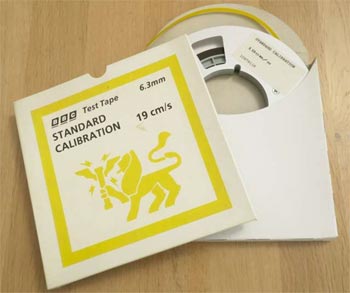
BBC Standard Calibration Tape for 19cm/s.
For convenience, many engineers spliced their line-up, 15 and 7 ½ ips frequency calibration tapes together on a single reel. This practice ultimately led to the production of an official so-called 'Composite Calibration' tape, which saved them the trouble!
The job of calculating reference flux level and other parameters was the responsibility of BBC Designs Department, which held the BBC calibration tape standard and issued 'reference masters' that could be used in the creation of batches of replay calibration tapes for day to day use by the engineering staff tasked with maintaining studio and office machines. In fact, Designs Department also supplied the original custom-made hardware for the automatic production of calibration tapes. This could be programmed with sequences of tones of the required level and duration, separated by spoken announcements - the latter usually provided by a Radio 4 announcer, giving the tapes a certain 'BBC gravitas'. In spite of the automation, the production of calibration tapes to the required high standard was a time consuming and painstaking process.
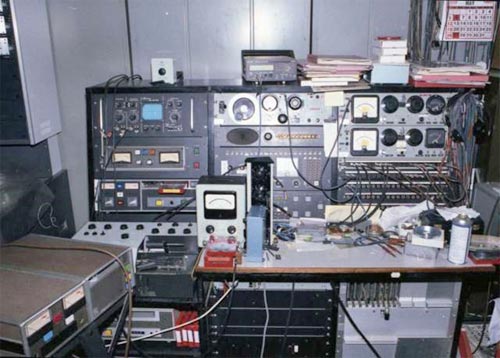
BBC Designs Department Test Tape Maker, 1985.
By the time I became involved in calibration tape production, a Telefunken M15A with a full-track record head was being used for this purpose. Although the recordings were made on standard BBC Type 200 blank tape stock, this was hand-picked for low phase-jitter to ensure a stable replay azimuth could be achieved. The overall stability and consistency of the M15A's performance was legendary amongst the BBC engineers who maintained these recorders, the only criticism being that it was very sensitive to poorly slit tape. When the calibration tape production recorder was replaced in the late 1980s, a Studer A820 was chosen, partly because its tape transport gave more consistent azimuth but also because of its more versatile control interface. This period also marked the retirement of the old Designs Department test tape production hardware: it was replaced with a computer that controlled a Lindos LA100 audio test set for generation and monitoring of the tones and stored spoken announcements on disk. Unfortunately, the limited data storage capacity of the chosen system meant that the announcements were digitally encoded at low resolution, so although they were perfectly intelligible they never sounded as good as the analogue version on the earlier calibration tapes. This system was installed at TSU in Daventry (previous production having been done at Broadcasting House in London) and was used to produce calibration tapes until the late 1990s.
Tape handling, storage and archiving
Much has been written on these subjects over the years and I don't intend to go into much detail here. One of our contacts in the tape industry summed up the temperature and humidity recommendations for tape storage by saying: "If it's a comfortable environment for human beings, it's likely to be a good storage environment for tape, too." What has only become evident with the passing years is just how resilient and long-lived tape recordings are proving to be. With the odd exception - for example the 'sticky shed syndrome' mentioned earlier - recordings from several decades ago generally seem to have suffered remarkably little deterioration. Of course, in the early days of recording, the only options were non-erasable disc and magnetic tape. The choice between them was solely based on sound quality and convenience rather than the predicted longevity of recordings.
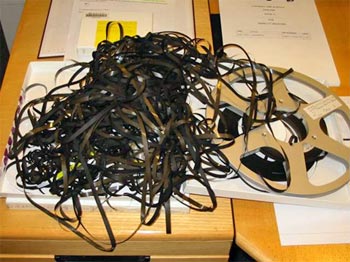
A spilled tape received by the Recorded Programmes
Library in Broadcasting House. It was eventually restored to playable
condition!
One particularly interesting situation emerged when it was proposed to relocate a large part of the BBC's audio tape archive to the Brookmans Park transmitter site in the early 1990s. From a practical point of view this made a lot of sense: modern transmitter hardware was much smaller than that which the site had been built to accommodate, so there was plenty of space available for both storage and archive operations. It would also free up much more valuable space at Broadcasting House in central London. However there were two concerns regarding this proposal. The first was that recordings would not be as readily available and would either need to be physically transported between Brookmans Park and Broadcasting House, or played in real time over a link. The latter was addressed to some extent by the installation of an ingenious transfer system based around a video link and Studer A80 machines that were modified to play back and record high speed (around 100 inches per second, if I remember correctly). The second concern was more fundamental and related to the fact that Brookmans Park still operated very powerful transmitters. What if the electromagnetic field around them posed a risk to magnetic recordings? Anecdotal evidence suggested that this concern was unfounded, as the magnetic component of the field was very small, even in the nearby transmitter buildings. The concern was that all enquiries about the possible effects on recording tape were answered by phrases such as "it's unlikely to be a problem", rather than by a definitive answer. In some cases, the response from recording industry professionals was a bemused: "Why on earth would you risk doing that?"! In view of what was at stake a thorough investigation was carried out. Part of this work involved recording a series of custom calibration tapes, measuring and logging their replay characteristics, and repeating the measurements at intervals over a period of several months. Control tapes were kept at Broadcasting House and other samples were stored in various locations at Brookmans Park. The investigation concluded that whilst there was little risk of tapes suffering demagnetization effects in storage, there was a small possibility that recordings could be damaged when being replayed at the site: In theory, it was possible for a playback head to demodulate a strong RF signal and record audio onto a tape that was simply being replayed. Provided good quality, well-maintained tape machines were used, this risk was considered to be very low. In the event, some areas of the site were screened from RF to provide additional reassurance and the archive operated successfully at Brookmans Park for several years. The main problems encountered as a result of the local RF field were confined to the telephone system and some domestic audio equipment used in offices at the site. This was perhaps not surprising, as even the heating system and light fittings around the buildings could sometimes be heard emitting speech and music!
The dawn of digital recording
By the early 1980s, a handful of digital audio recorders such as the Mitsubishi MX80 and Sony PCM-F1 were being evaluated by BBC Radio. There was a lot of interest in these, although their high cost and more complex editing requirements limited them to a few specialist applications. There was also some 'cheating' necessary in order to improve the practicality of digital recordings. For example the open-reel MX80 recorder had a separate analogue monitoring track so that replay was not subject to the delay inherent in a digital signal path. This helped a user to locate editing points although I'm not sure whether razor-blade editing would have been entirely successful owing to the data discontinuities that this must have introduced.
1983 marked the launch of the Compact Disc (CD) in the UK and its excellent technical performance further highlighted the technical limitations of analogue recording. However until recordable CD (CD-R) emerged in 1990 the medium was restricted to replaying commercial recordings pressed from a 'stamper' - a process similar to that used to produce vinyl records. DAT cassette - widely used in the BBC from 1986 - was a recordable medium, although the tapes themselves could not be edited. As a result, analogue open-reel tape remained the mainstream recording medium in the many applications where the ability to rapidly edit content took priority over ultimate audio quality. The superior audio performance of DAT was soon acknowledged by Radio 3, and it was particularly well suited to some of their operations, such as the playout of complete concerts or other programmes recorded in advance of transmission.
Looking back, what strikes me about the period around the early 1980s is that analogue open-reel tape was already looking as though its days were numbered, yet it was a further 20 years before the BBC stopped using it for new recordings. This was partly due to the high cost of replacing analogue hardware and production workflows in an organisation the size of the BBC; but it is also testament to analogue open-reel's fitness for purpose as a broadcast recording medium. Whilst digital media offered many technical benefits, until hard disk editing became established, no other medium could match the speed with which analogue tape could be used to capture, edit and then play recorded audio to air.
Compact Disc (1983)
The CD format was the product of an alliance between Philips and Sony and was launched in Japan in 1982. This was around the time that I started working for BBC Radio and it was during the early part of 1983 that the first CD players appeared in the UK. There was great excitement amongst audio enthusiasts - not only did the CD medium have marketing appeal - it was much smaller than LPs, silver, shiny and was read by a laser - but it also promised superior audio performance to all that had gone before.
My feelings were mixed when I heard one of the first CD players in a listening room in the basement of Broadcasting House. Expectations were high, and CD certainly delivered its promises of very low noise, speed stability, convenience and (up to a point) resilience to handling damage. But I soon realised that an absence of wow & flutter and noise on commercial music releases didn't guarantee a better listening experience. Ironically, it was often good re-masters of 1950s and 60s jazz recordings that impressed most on this new audio medium - even though analogue tape noise was still audible. This was quite an eye (ear?)-opener for me at the time and a good lesson in appreciating what really matters in audio reproduction.
Of course, the potential improvement in audio quality that CD promised over vinyl disc was of limited benefit for radio broadcast - especially when the audio was destined to be dynamically processed and equalised for delivery on FM or AM. It was the convenience and robustness of the CD format that made it the logical successor to vinyl disc and it soon became well established in BBC studios. However there were a couple of issues with the early adoption of the CD format…
Firstly, the high initial cost of professional CD players meant that domestic machines were often adopted for studio use. This normally just required the insertion of an unbalanced to balanced interface converter between the player's analogue output and desk input. But a feature of the digital to analogue converters used in some early CD players was that they were time-shared between the left and right stereo channels, producing a slight inter-channel phase offset. Although this was fine for domestic stereo reproduction, BBC Radio had to consider the phase cancellation effect for its mono listeners. So in order to avoid a loss of high frequencies in mono, a special interface converter was used, which inserted a delay in the 'early' stereo channel so as to realign it with its partner.
Secondly, it was necessary to establish a sensible replay line-up so that commercial CDs delivered similar peak and average levels to that from the tape and disc reproducers already in our studios. In those pre-'loudness war' days, commercial CDs tended to be mastered with a few dBs of headroom - or at least, only very occasional peaks to 0dBFS. Tests using a wide range of commercial CDs showed that by aligning the players so that 0dBFS tone from a test CD corresponded to PPM 7 on output, rather than PPM 6, commercial music releases could generally be played back without the need for further level adjustment on the studio desk.
As time went on and CD became more established, domestic players were relegated to office use, with professional models such as the Sony CDP3000 and Studer A730 taking over studio duties.
Error detection, correction and concealment
For those used to analogue audio's gradual sound quality deterioration - as a result of physical media damage, mechanical misalignment, fault conditions and just normal wear and tear - CD was a revelation. It continued to sound as good as new even after repeated playing or a modest amount of handling damage. But of course there was a limit to its capabilities and on reaching this, the effect of further data loss resulted in a 'cliff edge' effect. Suddenly, perfectly clean audio could suffer from audible dropouts, clicks or complete failure to play. Another characteristic that became apparent was that the error correction performance of a CD player often bore little or no relationship to its cost: More expensive hardware tended to bring only greater durability and more operational features. As a result BBC users of the CD format were often a little frustrated when they found that a disc that had played perfectly on their £200 office machine had subsequently glitched on air in a studio player costing nearly ten times as much!
Engineering staff were trained to understand how a digital recording medium such as CD ensured the integrity of the data being recorded and replayed. Unfortunately, many people thought that the words 'digital' and 'perfection' were synonymous. This was understandable, given that the advertising slogan "Perfect sound forever" had been used to describe the CD format. Although the audio data derived from a CD is digital, the method of retrieving the information from the spiral of pits and lands on a CD is essentially still an analogue process. In reality, the performance of this new format was still constrained by mechanical tolerances and many of the other physical limitations that had affected the performance of analogue tape. The difference for digital recording and replay was that the impact on the audio performance of mechanical tolerances was 'cushioned' by some clever maths that could replace a certain amount of lost data. It also meant that effort spent perfecting the mechanical performance of a device such as a CD player did not necessarily translate into significantly better sound quality - unless it eradicated digital errors that had previously been audible as clicks, mutes or mis-tracking. The first thing we needed to do was to become familiar with a digital system's tolerance for lost data, and to understand terms such as bit error rate and its impact on performance.
Perhaps the most challenging aspect of error rate measurement is that the performance of a moving recording medium is inextricably linked to the behaviour of the playback device. So, for example, a particular error rate reported by a CD tester based on a certain make and model of player, will not necessarily translate into similar performance when the same disc is played on a different transport mechanism. The ability to give advice on what represents a 'good' CD as opposed to one that is likely to cause audible problems on replay requires considerable experience gained from testing many different samples of media.
To my knowledge, the first device used to measure CD error rate in the BBC was based on a domestic Philips CD player (which at the time employed a chipset that allowed access to the block error rate flag) and a BBC Microcomputer. It was developed by an engineering colleague in about 1984 and was subsequently used to help ensure trouble-free replay of CDs on air. This was particularly helpful for Radio 3, which had started to broadcast complete classical works from CD around that time.
A second problem with error rate measurement is determining sensible pass/fail criteria for each performance parameter. Although performance limits and tolerances can be found in the relevant standards, these do not always reflect current performance expectations - many standards having been defined years previously and not updated. Again, there is no substitute for experience in testing a wide range of media and replay hardware.
A third problem arises when trying to relate the above pass / fail criteria to media archival life. For example, is it possible to measure any deterioration in performance due to ageing of the medium and if so, what margin is required to ensure long-term playability?
A further dimension was added to CD testing when it evolved into a recordable format in 1990. Although audio CD-Rs were designed for compatible replay on the same players used for pressed CD media, their physical properties - hence their typical error rates and other parameters - were somewhat different, so expectations had to be adjusted accordingly. But before CD-R arrived on the scene, BBC Radio embraced DAT as its new high quality recording format.
DAT cassette (1986)
DAT was originally conceived as the replacement for Compact Cassette in the 'digital age'- in other words it was intended to be a consumer rather than a professional recording format. There are parallels in the way that both these formats developed beyond their original intended market. Compact Cassette had been designed for duties such as office dictation and low-quality portable recording, but evolved into a respectable hi-fi medium. DAT was initially aimed at the consumer market but the hardware was complex and recorders were too expensive for the average home user. On the other hand, its impressive technical performance quickly led to audio professionals adopting it for studio use. For this market, its relatively high cost still represented good value compared to professional open-reel recorders.
My recollection of DAT's launch is that a delegation of senior staff from Sony visited the BBC in 1986 to demonstrate their DTC-1000 DAT recorder. The sample they brought with them from Japan was a 100 Volt version that lacked a voltage selector to allow connection to our 240 Volt mains supply. In their haste to test the recorder before their meeting at Broadcasting House, they had used some sort of crude voltage step-down device and had blown the fusible link in the transformer! Luckily, the ever helpful staff in BH Mechanical Workshop saved the day by carefully drilling away the transformer's potting compound and repairing the fusible link so that the demonstration could go ahead as planned.
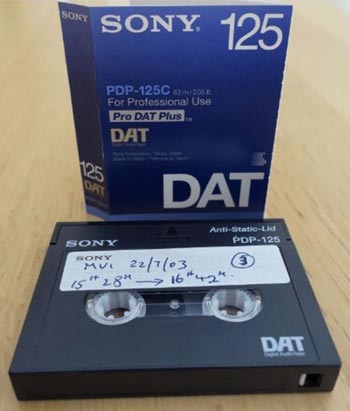
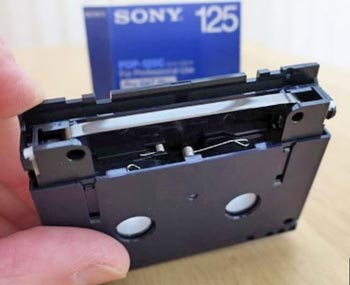
DAT Cassettes were tiny and required high-precision
miniature tape transports.
There was always something of a love-hate relationship with DAT in the BBC. Most users appreciated its high audio quality and convenience, but were frustrated by the inability to edit material without time-consuming dubbing. There were also instances of tapes jamming or producing audible glitching. Maintenance engineers found the complexity and small size of DAT recorder mechanisms a challenge, but on the other hand they didn't have the record/replay calibration issues associated with analogue tape in order to maintain a flat frequency response.
Another practical problem with DAT was that the cassette cases were too small to hold an A4 paper Recording Report (the only recording metadata at the time). This was solved by the use of cardboard boxes that were large enough to hold a folded Recording Report and DAT cassette and also allowed a larger spine label to be applied, making it more legible on a library shelf.
The audio performance of the 16-bit DAT format was generally considered beyond reproach, at a time when higher bit-depths and sample rates were not generally available. DAT recorders could be set to either 44.1kHz (equivalent to CD) or 48kHz sample rate. In accordance with EBU recommendations for digital recording and broadcast, the BBC adopted 48kHz as the standard sample rate for its DAT recorders. There was much discussion about how much recording headroom was required, but a static line-up in which an analogue input level of +18dBu (1kHz tone) equated to 0dBFS (digital maximum coding level) was eventually adopted by the BBC and also the EBU. Some users considered this to be a 'waste of bits', there being a seemingly over-generous 10dB of headroom above PPM 6. In practice of course, the PPM's tendency to under-read must be taken into account and the actual headroom on programme material that is 'peaked to 6' can easily be less than 5dB. Once allowance is also made for the unpredictability of peak levels during a live recording, it is clear that a line-up headroom of 10dB on tone is not excessive. Most users also soon appreciated that even when recordings had a generous amount of peak headroom, the noise floor of DAT was never intrusive in the way that it could be with analogue tape. Even via FM broadcast, analogue tape hiss could still be heard over other noise sources in the signal chain and this was no longer the case with DAT recordings.
By 2004, the major DAT recorder manufacturers had begun to discontinue their product ranges and it was clear that the BBC's 18 year relationship with the DAT medium would have to end. There followed a concerted effort to exclude DAT from new studio facilities and they have not been officially supported for many years. This is not to say that a few DAT machines won't still be found in BBC service, but they are considered legacy equipment and are not generally used for anything other than archival transfer.
Recordable CD (1990)
At its launch, recordable CD seemed like the most incredible and improbable of all audio formats. It was incredible in the way that it used a laser to 'burn' recordings onto a blank CD; improbable in that it was initially so expensive as to have very limited application. Of course, the cost came down as CD-R was adopted as a medium for data storage, but in 1990 it was hard to imagine that the hardware and blank media prices would plummet in the way that they did.
The first recordable CD system that I evaluated for BBC Radio was the interestingly named Gotham Spot 90. This was not a single device like the now familiar CD burners used in PCs and laptops, but a whole rack of hardware, comprising a DAT recorder, separate Yamaha CD encoder and writer units, computer controller, display monitor, keyboard and mouse. The method of creating a disc involved first recording the tracks for the CD-R onto a DAT tape, ensuring that the first few minutes of the tape were left blank. The computer system then created a table of contents (TOC) based on the order and spacing of the DAT recordings. It wrote this as a header at the start of the tape, which was then played back to produce the CD recording complete with its TOC, making the disc compatible with any ordinary CD player. If this sounds like a clunky process - it was!

An early production CD-R used for test purposes
by BBC Radio in 1990.
By 1992 more usable and affordable hardware had become available, notably the Yamaha YPDR601 and BBC Radio purchased one of these for applications such as the production of custom sound effects discs. Blank CD-Rs had also fallen in price to around £10. However they were still expensive compared to DAT cassettes, which were under £5 (and could hold up to 2 hours of audio), plus of course they couldn't be re-used: Mistakes - the creation of so-called 'coasters' - during recording, were all too common!
For a number of years, CD-R was seen as a niche format by the BBC: It was useful for certain applications, but still relatively expensive in terms of hardware and running costs.
One area where CD-R immediately started to generate interest was for archiving. At launch, media manufacturers had been cautious in their claims. CD-Rs were generally advertised as having an archival life - once recorded - of 'at least 10 years'. The shelf-life quoted for blanks was initially only 1 year. A similar lifespan had been predicted for DAT cassettes, leading some archiving professionals to question whether either medium was suitable for long-term storage. By this time, there was a fair degree of confidence in analogue tape, some of which had already survived several decades in storage and was showing little sign of further deterioration.
In due course, CD-R manufacturers became more confident in their claims - some predicting that their media would remain playable for 50 or even 100 years. Organisations with large audio libraries such as the BBC began to consider CD-R as a viable archival storage medium. Only time will tell whether this confidence was misplaced, but from the late 1990s onward there was a large investment in CD-R for this purpose.
One thing that became apparent as CD-R evolved was that its development was increasingly driven by the needs of the computer data storage, rather than the audio recording, market. This was helpful in driving down the cost of CD recorders and media, but had implications for our use of CD-R as a 'Red Book' audio format. It emerged that some types of media that had been optimised for high speed data transfer, performed inconsistently (or sometimes did not work at all!) when used to record and replay at real time speed in our studio and office CD machines.
The result of this was that much time and effort was devoted to selecting media that was as widely compatible as possible, but at the same time had a long archival life. In many respects, there were parallels with the BBC's approach to its tape specification, decades earlier.

The three main organic dye types used for the recording
layer in CD-R media.
Some products also featured a special coating on the label side that was intended to make them more resilient, especially when directly written on with a CD pen.
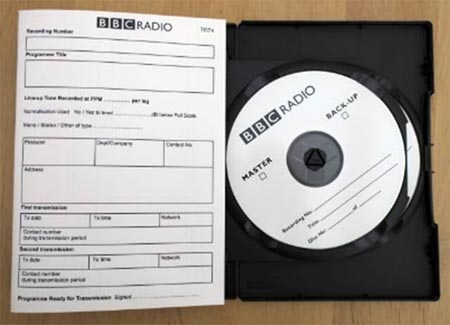
BBC Radio TX CD-Rs were supplied in DVD boxes complete
with a blank Recording Report and guidance on how to handle and clean
a disc. Two discs were included so that a master and backup could be created.
It's fair to say that despite the use of error measurement equipment and recommendations as to the most compatible blank discs and write speeds, CD-R has always been prone to creating the odd 'coaster'. Nevertheless, they became BBC Radio's preferred programme delivery and archival medium for several years from the late 1990s. Aside from compatibility issues, there was still a misplaced perception amongst some users that the odd scratch or finger-mark would not affect replay. To help minimise the number of on-air failures, we regularly had to remind users of the correct handling and cleaning procedures.
The later introduction of CD-RW - a rewritable version of CD-R - had the potential to reduce costs by allowing erasure and re-recording. In practice, CD-RW was not widely adopted in the BBC due to additional (over and above CD-R) compatibility and longevity concerns. The media also cost more, and since CD-R blanks were only a few tens of pence by the time they were in widespread use, CD-RW did not deliver a significant advantage.
Magneto-Optical (M-O) Disk and MiniDisc
At around the same time as the launch of CD-R, the BBC was beginning trials of Magneto-Optical (M-O) disk recorders such as the Akai DD-1000. This was an attractive format because it offered the ability to non-destructively edit audio content in a way that we now take for granted. Unfortunately, the hardware was expensive, and unlike CD-R, which could be played on the CD player in any studio or office, M-O discs could only be used on proprietary hardware.

In spite of its origins as a consumer format, some
MiniDisc media was aimed squarely at professional users. This example
featured a slightly larger case which made it easier to include recording
details.
Digital Compact Cassette (DCC)
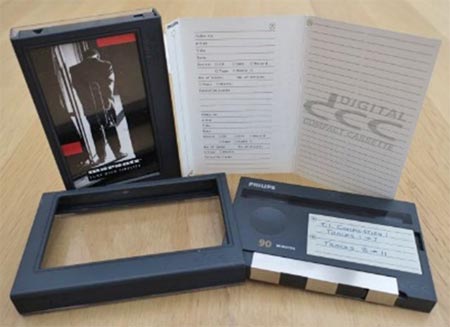
A pre-recorded Marantz demo DCC and a Philips blank
DCC. Note the sliding metal flap to protect the high coercivity metal
particle tape.
The main problem for DCC was that, in an age of rapid track access, the need to wait while the tape was shuttled back and forth to locate a recorded item seemed rather antiquated. To some extent the presence of both MiniDisc and DCC on the market at the same time simply confused the consumer - as had happened with VHS and Betamax video formats. After the demise of DCC, MiniDisc was given a second wave of publicity and gained in popularity before solid state storage media and audio streaming finally took over. A brief evaluation of DCC was carried out by BBC Radio but to my knowledge it was never adopted for studio use.
Recordable DVD (DVD-R, DVD+R, DVD-RW)
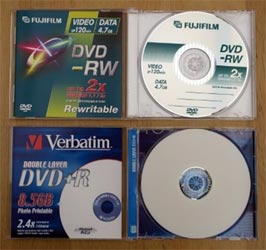
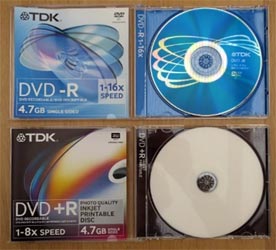
A small selection of the bewildering range of recordable
DVD media.
Flash memory
Prior to solid state recording methods, both analogue and digital media had relied on precision moving parts to make them work. Even hard disk drives could be affected by vibration and mechanical failure, so the use of flash memory promised much greater reliability.
In reality, flash card audio recording has not been entirely free from problems…
Although many of the theoretical benefits have been realised, users quickly found that there were still compatibility issues between brands and capacities of card and the recording hardware. In particular, cards that had been formatted and used on one manufacturer's recorder would sometimes be unusable on another brand of device. This could be very frustrating for users, who then had to search for an alternative - preferably brand new - card on which to record.
Other problems emerged relating to specific recording hardware. These have occasionally been obscure, with faults sometimes being very difficult to reproduce, let alone cure.
Reliability seemed to improve as SD card took over from Compact Flash (CF) as the storage medium.
Hard disk and cloud storage
To round off this article, it's only right that I mention hard disk recording and cloud storage in passing, although as with flash cards these could be regarded as just alternative forms of data storage rather than being specific to audio applications. These storage methods also mark the transition from physical media that eventually end up on a library shelf, to an era in which recordings have no single home but are subject to continual regeneration and duplication in an effort to keep them for posterity.
In conclusion
Today, if I was asked to name the most important benefit to BBC Radio of the latest digital storage media over analogue tape, I would say 'accessibility'. If asked the same question 30 years ago, I might have answered 'sound quality', but experience has shown that, for radio broadcasting at least, digital recording has not greatly enhanced the audio quality for our audience. What it has done is ensured greater consistency, flexibility in terms of editing and - through network connections - incredible ease of delivery of both content and metadata to programme makers and consumers, without the need to transport physical media.

